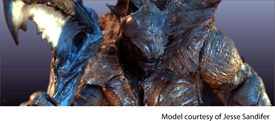 |
Viewport 2.0 now supports the DirectX 11 rendering engine for Windows 64-bit systems. You can run Viewport 2.0 in either DirectX 11 or OpenGL mode. HLSL shaders are supported with DirectX 11 and a sample shader (AutodeskUberShader.fxo) is provided and automatically loaded when a DirectX11 Shader is created. The DirectX 11 AutodeskUberShader allows you to work with features such as tessellated displacement, translucency, blurred reflections and so forth directly in Maya. Lights and light parameters are automatically connected through implicit light binding. All light modes (default, use selected, use none, use all) are supported, as well as both textured and non-textured modes. The dx11Shader.mll plug-in also provides semantics for creating an organized and simple Attribute Editor for your HLSL shader, as demonstrated by the AutodeskUberShader. It allows for interoperability between Mudbox and Maya. Using DirectX 11 with Viewport 2.0, you can see the displaced results of your Mudbox model realtime directly in the Maya scene view, without needing to render. In addition, Viewport 2.0 also supports several new shaders and utility nodes, mental ray objects, NURBS features, and other features such as filtering and templating. Furthermore, there are performance improvements in several areas.
|
You can now paint your vertices with a color set in Viewport 2.0. In addition, you can also color your vertices based on influence color in Viewport 2.0.
You can now enable the new Skip existing frames attribute in the Render Settings: Common tab so that the renderer detects and skips over frames that have already been rendered. You can also use the -skipExistingFrames flag with the command line renderer. This feature saves rendering time.
Maya supports source objects with hardware shaders derived from MPxHwShaderNode. You can then use the Transfer Maps functionality to bake a Shaded output map (lit and shaded color map) from a source to a target mesh.
When batch rendering with mental ray, if mental ray does not render your animation correctly, use the new -perframe flag to re-translate the frames from scratch.
A new Force raytraced camera clipping attribute has been added to the Render Settings: Options tab so that, when enabled, the near and far clipping planes are respected for primary rays shot from the camera when rendering with mental ray for Maya. The option is disabled by default, but can be enabled via the Render Settings: Options tab.
A new Force raytraced camera motion vector computation attribute has been added to the Render Settings: Options tab so that, if you disable Scanline and enable BSP2, you can enable this option to enforce the adding of a camera motion effect to the computed motion vectors.
mental ray for Maya now renders your material assignments correctly when all of the faces of a surface have had a material override. You can revert to legacy behavior by setting an environment variable.
The ZIPS image compression method is now available if you select OpenEXR as your output image format in the Render Settings window: Common tab.
 Except where otherwise noted, this work is licensed under a Creative Commons Attribution-NonCommercial-ShareAlike 3.0 Unported License
Except where otherwise noted, this work is licensed under a Creative Commons Attribution-NonCommercial-ShareAlike 3.0 Unported License